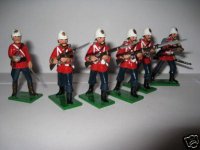Ok now I am confused (sorry I am not always the sharpest knife in the drawer) but the box lists as
The Zulu War -Advancing Set 13th Regt.
but you said the 13th Regt wasn't at zululand

Here is some info from A History of the SOMERSET LIGHT INFANTRY
"The war began in January 1879: Cetewayo had forces estimated to number around 40,000 men, all of which were extremely mobile. Lieutenant-General Lord Chelmsford was placed in charge of the British forces, which he organised into five separate columns, of which the 13th formed part of the number 4 column, based at Utrecht. The aim of the campaign was to secure Natal and the Transvaal from invasion. An ultimatum was delivered to Cetewayo, which upon expiry on 11 January 1879, led to the invasion of Zululand by columns 1, 3 and 4, with the other two columns remaining in defence.
During the first two weeks of the campaign the British army received unmitigated disaster. On 11 January, number 3 colony crossed the Tugela River at Rorke's Drift, leaving a small garrison there they continued to Isandhlwana. On the 22 January a huge force of Zulus attacked Isandhlwana killing 52 officers and 806 other ranks. They then attacked the garrison at Rorke's Drift, where just 145 men, after ten hours of fierce fighting, drove off the attacking Zulus, a scene made famous by the 1964 film Zulu. British moral had been severely dented by the attack on Isandhlwana, much ammunition, all the transport and supplies from the 3rd column had been lost and it was feared that an invasion of British territory would follow, although luckily the Zulu's did not follow up their success and British forces gained much needed breathing space.
At the end of January number 4 column and the companies of the 13th moved to Kambula Hill, which lay on the slopes of Ngabaka Hawane Mountain. Kambula covered the approaches to Utrect and was thus an important defensive garrison and also a by-station for captured and surrendered Zulus.
A force of 20,000 strong Zulu's advanced on Kambula and on the afternoon of 29 March 1879 formed their traditional attack position resembling a bull's head. 100 mounted men were sent out of the fort to engage with the right wing of the Zulu attack, it was hoped to entice the Zulus into making a premature attack. The Zulus fell for the trick and advanced, whilst the British forces retired to the fort. When the enemy came within 300 yards of the garrison they were greeted by tremendous firepower. After a day fighting the Zulu forces were driven back with an estimated death of 2,000 Zulus and only 18 British.
The 1st battalion remained camped at Kambula until early May when it marched to Mumhla Hill and then onto the Umyanyene River where it met up with Lord Chelmsford in early June. By the end of June the battalion was stationed at Entonjaneni Hill, which lay just 16 miles from Ulundi, the Zulu headquarters. Whilst here the Zulu King sent out envoys of peace, which led to no resolution. On the 5 July 1879 the British forces crossed the Umvolosi River, and took up a square formation for battle; the mounted men formed a hollow rectangle, with the 13th on the right flank, the guns and gatlings were placed in pairs at the corners, with the ammunition and tool carts, the bearer company and Natal Pioneers in the centre. The Zulu's advanced on the square but the firepower was too strong. The enemy was finally defeated by an attack from the 17th Lancers. The Battle of Ulundi totally crushed the military strength of Cetewayo, the Zulu warriors returned to their kraals and the King fled. Soon after, on 1 August, the services of the 13th were no longer needed and thus embarked for England."
Cheers
Martyn




